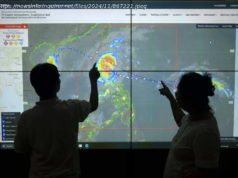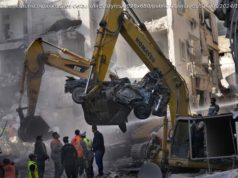 TEHRAN, Iran — Former Iranian President Akbar Hashemi Rafsanjani, a wily political survivor and multimillionaire mogul who remained among the ruling elite despite moderate views, died Sunday, state TV reported. He was 82.
TEHRAN, Iran — Former Iranian President Akbar Hashemi Rafsanjani, a wily political survivor and multimillionaire mogul who remained among the ruling elite despite moderate views, died Sunday, state TV reported. He was 82.
Iranian media reported earlier Sunday that he was taken to a hospital north of Tehran because of a heart condition. State television broke into programming to announce his death, the female newscaster’s voice quivering as she read the news.
She said Rafsanjani, “after a life full of restless efforts in the path of Islam and revolution, had departed for lofty heaven.”
Rafsanjani’s mix of sly wit and reputation for cunning moves — both in politics and business — earned him a host of nicknames such as Akbar Shah, or Great King, during a life that touched every major event in Iranian affairs since before the 1979 Islamic Revolution.
His presence — whether directly or through back channels — was felt in many forms. He was a steady leader in the turbulent years following the overthrow of the U. S.-backed shah, a veteran warrior in the country’s internal political battles and a covert go-between in intrigue such as the Iran-Contra arms deals in the 1980s.
He also was handed an unexpected political resurgence in his later years.
The surprise presidential election in 2013 of Rafsanjani’s political soul mate, Hassan Rouhani, gave the former president an insider role in reform-minded efforts that included Rouhani’s push for direct nuclear talks with Washington. World powers and Iran ultimately struck a deal to limit the country’s nuclear enrichment in exchange for the lifting of some economic sanctions.
While Rafsanjani was blocked from the 2013 ballot by Iran’s election overseers — presumably worried about boosting his already wide-ranging influence — the former leader embraced Rouhani’s success.
“Now I can easily die since people are able to decide their fate by themselves,” he reportedly said last March.
However, Rouhani now faces a crucial presidential election in May which will serve as a referendum on the deal and thawing relations with the West. Rafsanjani was sharply critical of a move by Iran’s constitutional watchdog to block moderates, including Hassan Khomeini, the grandson of the Islamic Republic’s founder, from running for a top clerical body in elections last year.
Rafsanjani was a close aide of Ayatollah Ruhollah Khomeini and served as president from 1989 to 1997 during a period of significant changes in Iran. At the time, the country was struggling to rebuild its economy after a devastating 1980-88 war with Iraq, while also cautiously allowing some wider freedoms, as seen in Iran’s highly regarded film and media industry.
He also oversaw key developments in Iran’s nuclear program by negotiating deals with Russia to build an energy-producing reactor in Bushehr, which finally went into service in 2011 after long delays. Behind the scenes, he directed the secret purchase of technology and equipment from Pakistan and elsewhere.
Rafsanjani managed to remain within the ruling theocracy after leaving office, but any dreams of taking on a higher-profile role collapsed with Mahmoud Ahmadinejad’s disputed re-election in 2009 and the intense crackdown that followed. Rafsanjani’s harsh criticism of Ahmadinejad branded him as a dissenter in the eyes of many conservatives.
In a sign of his waning powers, Rafsanjani’s stance cost him his position as one of the Friday prayer leaders at Tehran University, a highly influential position that often is the forum for significant policy statements.
But some analysts believe that Rafsanjani was kept within the ruling fold as a potential mediator with America and its allies in the standoff over Iran’s nuclear program. His past stature as a trusted Khomeini ally also offered him political protection. Rafsanjani was a top commander in the war with Iraq and played a key role in convincing Khomeini to accept a cease-fire after years of crippling stalemate.
Nearly 25 years later, Rafsanjani tried to revive his credentials among a new generation of reformers by recounting proposals he made to Khomeini in the late 1980s to consider outreach to the United States, still seen by hard-liners as the “Great Satan.”
His image, however, also had darker undertones. He was named by prosecutors in Argentina among Iranian officials suspected of links to a 1994 bombing of a Jewish center in Buenos Aires that killed 85 people. Some Iranian reformers accused him of involvement in the slaying of liberals and dissidents during his presidency — charges that were never pursued by Iranian authorities.
“The title of Islamic Republic is not just a formality,” he said in 2009 in the chaos after Ahmadinejad’s re-election.
“Rest assured, if one of those two aspects is damaged we will lose our revolution. If it loses its Islamic aspect, we will go astray. If it loses its republican aspect, (the Islamic Republic) will not be realized. Based on the reasons that I have offered, without people and their vote there would be no Islamic system.”
Rafsanjani — a portly man with only sparse and wispy chin hairs in contrast to the full beards worn by most Islamic clerics in Iran — first met Khomeini in the Shiite seminaries of Qom in the 1950s and later became a key figure in the Islamic uprising that toppled the U. S.-backed Shah Mohammad Reza Pahlavi in 1979.
His smooth-skinned visage gave him another nickname that also fit his ruthless image: The Shark.
He was elected as head of Iran’s parliament in 1980 and served until 1989, when he was elected for the first of two four-year terms as president.
Here, Rafsanjani began to build his multilayered — and sometimes contradictory — political nature: A supporter of free enterprise, a relative pragmatist toward foreign affairs and an unforgiving leader who showed no mercy to any challenges to his authority.
Rafsanjani took a dim view of state control of the economy — even in the turbulent years after the Islamic Revolution — and encouraged private businesses, development of Tehran’s stock market and ways to boost Iranian exports. His priority was to rebuild the country after eight years of bloody war with Iraq that killed an estimated 1 million people.
He built roads and connected villages to electrical, telephone and water networks for the first time, earning the title of Commander of Reconstruction by his supporters.
There were certain self-interests at play, as well.
Rafsanjani was assumed to be the head of a family-run pistachio business, which grew to become one of Iran’s largest exporters and provided the financial foundation for a business empire that would eventually include construction companies, an auto assembly plant, vast real estate holdings and a private airline. In 2003, he was listed among Iran’s “millionaire mullahs” by Forbes magazine.
His economic policies won him praise from Iran’s elite and merchant classes, but brought bitterness from struggling workers seeking greater state handouts. Rafsanjani also faced warnings from the ruling theocracy about pushing too far. None of his reforms dared to undercut the vast power of the Revolutionary Guard — which Rafsanjani briefly commanded, and which controls every key defense and strategic program.
Rafsanjani’s complex legacy also was shaped by the times.
He took over the presidency in a critical time of transition just after the death of Khomeini. He tried to make overtures for better ties with the U. S. after the American-led invasion of Kuwait in 1991 to drive out Iraqi forces, arguing that Iran paid too high a price for its diplomatic freeze with Washington.
But he could not overcome opposition from Iranian hard-liners and failed to win the backing of Khomeini’s successor as supreme leader, Ayatollah Ali Khamenei, for bold foreign policy moves. He also angered the West by strengthening Iran’s ties to armed groups such as Lebanon’s Hezbollah.
“One of the wrong things we did, in the revolutionary atmosphere, was constantly to make enemies,” he said in a 1987 interview.






